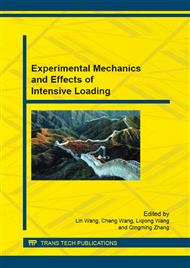[1]
M.A. Lavrentyev, Cumulative charge and its action, Mathematical sciences progress, 12 (1957) 41–56.
Google Scholar
[2]
G. Birkhoff, D. Mcdougall, E. Pugh and G. Taylor , Explosives with Lined Cavities, Journal of Applied Physics, 6 (1948) 563-582.
DOI: 10.1063/1.1698173
Google Scholar
[3]
R.J. Eichelberger, E.M. Pugh, Experimental Verification of the Theory of Jet Formation by Charges with Lined Conical Cavities, Journal of Applied Physics. 5 (1952) 537-542.
DOI: 10.1063/1.1702247
Google Scholar
[4]
E. M. Pugh, R. J. Eichelberger, N. Rostoker, Theory of Jet Formation by Charges with Lined Conical Cavities, Journal of Applied Physics, 5 (1963) 532-542.
DOI: 10.1063/1.1702246
Google Scholar
[5]
Clark, J. Flash Radiography Applied to Ordnance Problems / J. Clark / Journal of Applied Physics. – 1949. – Vol. 20, No. 1. – P. 263.
DOI: 10.1063/1.1698369
Google Scholar
[6]
J. M. Walsh, R. G. Shreffler and F. J. Willig, Limiting Conditions for Jet Formation in High Velocity Collisions, Journal of Applied Physics, 3 (1953) 349-354.
DOI: 10.1063/1.1721278
Google Scholar
[7]
W. Koski, F. Luky, R. Shreffler, F. Willig, Fast jets from collapsing cylinders, Journal of Applied Physics, 5 (1952) 1300-1305.
DOI: 10.1063/1.1702063
Google Scholar
[8]
Smirnov N.N., Nonstationary formation of a cumulative jet in a dense medium, Moscow University Mechanics Bulletin, Allerton Press, New York, 40 (1985) 1-11.
Google Scholar
[9]
Smirnov N.N., Formation of a cumulative jet. Moscow University Mechanics Bulletin, Allerton Press, New York, 38 (1981) 7-12.
Google Scholar
[10]
S.K. Godunov, A.A. Deribas, V.I. Mali. Material viscosity effect on jet-formation process in case of metal plates collision, Physics of combustion and explosion, 1 (1976) 3-18.
DOI: 10.1007/bf00742849
Google Scholar
[11]
A.G. Ivanov, L.I. Kochkin, L.V. Vasilyev. Explosive rupture of pipes, Physics of combustion and explosion, 1 (1974) 127–132.
Google Scholar
[12]
G.R. Cowan and A.H. Holtzman. Flow Configuration in Colliding Plates: Explosive Bonding, J. Appl. Phys, 4 (1963) 928- 937.
Google Scholar
[13]
Birkhoff, Q. Riabouchinsky Jubilee Volume Paris. 1 (1954) 1 - 12.
Google Scholar
[14]
P.C. Chou, J. Carleone and R.R. Karpp. Criteria for Jet Formation from Impinging Shells and Plates, J. Appl. Phys, 47 (1976) 2975-2981.
DOI: 10.1063/1.323038
Google Scholar
[15]
G.R. Cowan and A.H. Holtzman. Flow Configuration in Colliding Plates: Explosive Bonding, J. Appl. Phys, 4 (1963) 928- 937.
Google Scholar
[16]
V.F. Minin, I.V. Minin, O.V. Minin, Calculation Experiment Technology. / Chapter in: Computational Fluid Dynamics Technologies and Applications / Eds. by I.V. Minin, O.V. Minin, InTech, Chroatia, (2011).
DOI: 10.5772/686
Google Scholar
[17]
V.F. Minin, I.V. Minin, O.V. Minin. Physics of hypercumulation and combined cumulative charges, Gas and wave dynamics, 15 (2013) 281- 316.
DOI: 10.1109/apeie.2012.6629140
Google Scholar
[18]
V.F. Minin, I.V. Minin, O.V. Minin. Physics of cumulation: the future of hypercumulative regime of jet formation, Zababakhin Scientific Talks, International Conference, June 02–06 (2014) 37-38.
DOI: 10.4028/www.scientific.net/amm.782.42
Google Scholar
[19]
V.F. Minin, I.V. Minin, O.V. Minin. Innovative technology of creating hypercumulative shaped charges jet, 17th International Seminar New Trends in Research of Energetic Materials: Properties of Energetic Materials – Prediction and Reality, University of Pardubice, Pardubice, Czech Republic, April 9–11 (2014).
DOI: 10.4028/www.scientific.net/amm.782.42
Google Scholar
[20]
V.F. Minin, I.V. Minin, O.V. Minin. Technique and arrangement (variants) of high-velocity cumulative jets for perforation of boreholes with deep non-slugged channels and large diameter, Patent of R.F. 2412338, published 20. 02. (2011).
Google Scholar
[21]
S.A. Kinelovsky, A.V. Sokolov. Experimental modeling of plane jet flows of incompressible ideal fluid, Dynamics of continuous medium. – Novosibirsk, 62 (1983) 59 – 67.
Google Scholar
[22]
S.A. Kinelovsky, A.V. Sokolov. Nonsymmetric collision of plane jets of incompressible ideal fluid, PMTF, 1 (1986) 54 –57.
Google Scholar
[23]
N.S. Kozin, V.I. Mali, M.V. Rubtsov. Tangential discontinuity in case of bimetal coating collapse, FGV, 4 (1977) 619-625.
Google Scholar
[24]
S.A. Kinelovsky, Y.A. Trishin. Symmetric collision of two-layer jets of incompressible ideal fluid, PMTF, 2 (1980) 42 -52.
Google Scholar
[25]
V.F. Minin, I.V. Minin, O.V. Minin. Jet-formation criterion in axisymmetrical cumulative charges, Izvestia vuzov. Povolzhsky region. Technical sciences, 6 (2006) 380 - 389.
Google Scholar
[26]
V.F. Minin, I.V. Minin, O.V. Minin. Criterium of a Jet Formation on the Axisymmetrical Shaped Charge, International Journal of Modern Applied Physics, 3 (2013) 130-141.
DOI: 10.56431/p-uqnvly
Google Scholar
[27]
V.F. Minin, V.E. Fortov, A. V. Bushman, et al., Thermophysical and gasdynamic problems of antimeteorite protection for the Vega, spacecraft, Teplofiz. Vys. Temp., 22 (1984) 964-981.
Google Scholar
[28]
I.V. Minin, O.V. Minin. Some new principles of cumulative jets formation, Collected papers of Novosibirsk Military Institute, 7 (1999) 19-26.
Google Scholar
[29]
V.F. Minin, I.V. Minin, O.V. Minin. Hypervelocity fragment formation technology for ground-based laboratory tests, Acta Astronautica, 1 (2014) 77-83.
DOI: 10.1016/j.actaastro.2014.07.027
Google Scholar
[30]
V.F. Minin, I.V. Minin, O.V. Minin. Maximal velocity of continuous cumulative jet, Vestnik SGGA, 3 (2013) 128-137.
Google Scholar
[31]
I.V. Minin, O.V. Minin. Physical aspects of cumulative and fragmentation warheads, Novosibirsk, NGTU (2002) – 86 p.
Google Scholar
[32]
V.F. Minin, I.V. Minin, O.V. Minin. Physics of hypercumulation: a review, Proc. of 2013 Int. Forum on special equipments and Eng. Mech. - Science Press, USA, July 10-12, Nanjing, China, (2013) 45-55.
Google Scholar
[33]
V.F. Minin, I.V. Minin, O.V. Minin. Physics of hypercumulation: jet formation in shaped charge and ablatively-driven implosion of hollow cones, International Letters of Chemistry, Physics and Astronomy, 3 (2014) 76-86.
DOI: 10.18052/www.scipress.com/ilcpa.22.76
Google Scholar
[34]
V.F. Minin, I.V. Minin, O.V. Minin. Physics of hypercumulation and combined shaped charges. – Novosibirsk. – 2013. – 268p. (in Russian).
DOI: 10.1109/apeie.2012.6629140
Google Scholar
[35]
C. Wang, F. L. Huang, J. G. Ning, Jet formation and penetration mechanism of W typed shaped charge, Acta Mech Sin. 25 (2009) 107–120.
DOI: 10.1007/s10409-008-0212-8
Google Scholar
[36]
V.F. Minin, I.V. Minin, O.V. Minin. The Principle of Forced Jet Formation and any its Applications, Proc. International Workshop on Air Defense Lethality Enhancements and High Velocity Terminal ballistics, 29. Sept. -1 Oct. 1998, Freiburg, Germany, (1998).
Google Scholar


